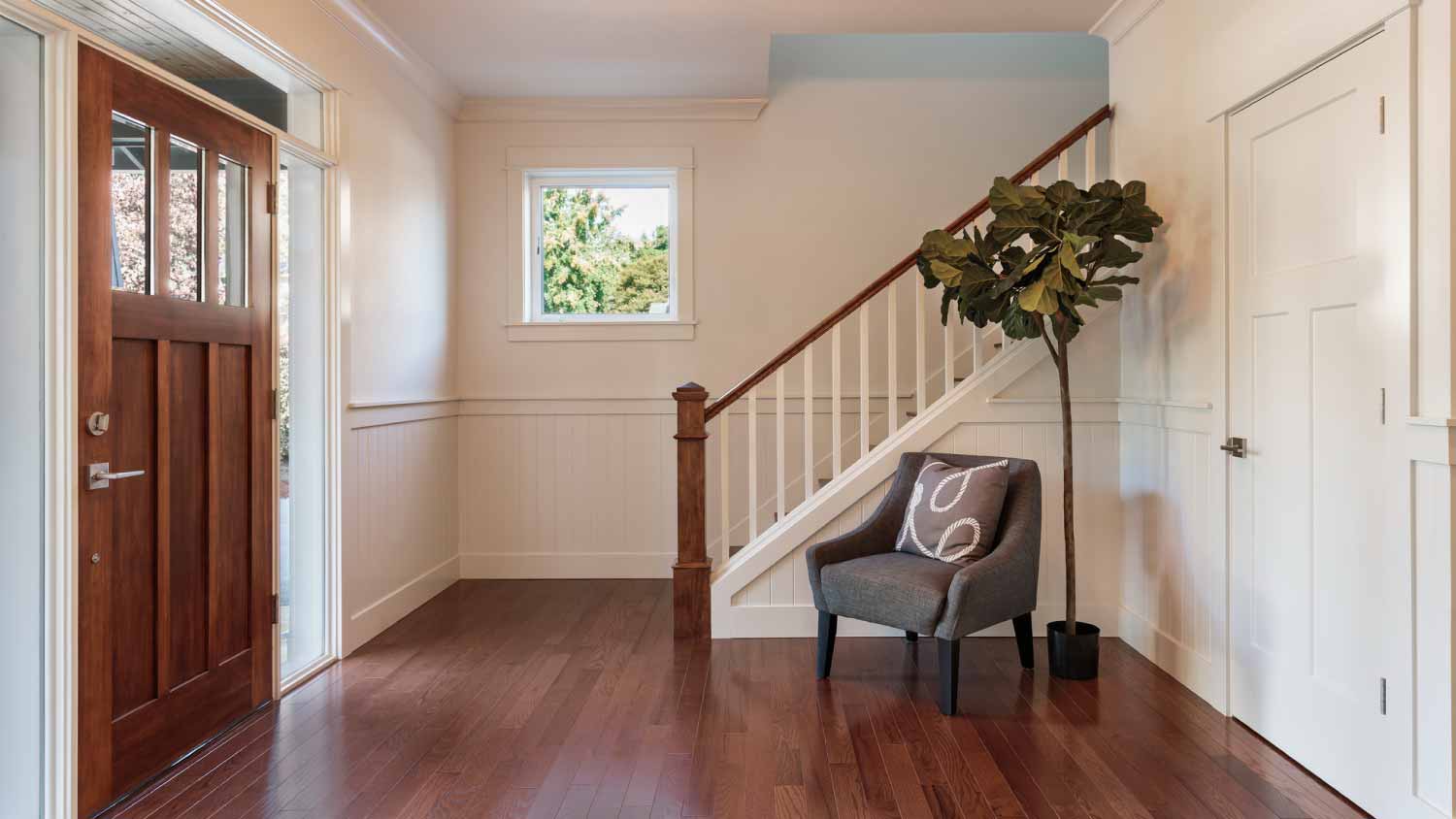How to Remove Old Laminate Flooring in 5 Steps
Ripping out old flooring is a task anyone can tackle


- Heavy-duty razor knife
- Roofers pry bar
- Hammer
- Putty knife
- Wet-dry vacuum
- Gloves
- Knee pads
- Dust mask
When you’re removing old laminate flooring, there’s a good possibility that it was previously glued down in one big sheet. Depending on how long ago the floor was installed, removing it can either be a huge chore or a straightforward separation from the subfloor.
Here is how to navigate the possibilities and remove laminate flooring.
Prepping to Remove Laminate Flooring
 Photo: Creativebird / iStock / Getty Images Plus / Getty Images, stayorgo / E+ / Getty Images, Dan Reynolds Photography / Moment / Getty Images
Photo: Creativebird / iStock / Getty Images Plus / Getty Images, stayorgo / E+ / Getty Images, Dan Reynolds Photography / Moment / Getty ImagesEvery flooring project requires a clean room to start. Before you begin tearing up your floor, vacuum the room thoroughly (making sure to cover the edges really well), then take a mop to the laminate. This will save you time in cleanup down the road and makes the job less of a sticky mess.
If you’re removing a lot of laminate (like an entire kitchen’s worth) you may want to rent a dumpster. Clear a pathway through your home that’s devoid of obstacles so you can carry the large sections of discarded flooring out to the garbage can or dumpster as you remove them.
Remove the Baseboard
Cutting flooring sheets isn’t an exact science, so it’s likely that the previous flooring installer laid down baseboard or quarter round molding to hide these minor imperfections. This means that in order to get a foothold on an edge so you can pry up the laminate, you’ll need to remove the baseboard first. If you’re careful enough, you can reuse these pieces of material when you install new flooring so proceed with the precision of a surgeon as you separate the trim from the wall.
Taking the pry bar, gently separate the baseboard from the walls. If you have sheetrock, it’s helpful to utilize a small piece of wood against the wall so that the pry bar doesn’t punch a hole as you apply pressure. Remove all of the baseboard and set it aside, being careful to snip off or hammer out the nails that held it to the wall.
Cut Sections With a Razor Knife
Because you’re destroying the flooring and (probably) throwing it away, slicing it up before you start prying the laminate is a good way to keep your debris manageable and easy to carry. Start at one end, eyeball a width of three feet across and cut deep into the laminate from end to end. Continue doing this until you’ve neatly divided the room into sections.
Pry Up the Laminate
Starting at any endpoint, use the putty knife to pry up along an edge. Once you’ve got about five inches of flooring eased up along one of your sections, try grabbing the whole piece to rip it up. Roll the flooring into a tube as you go and dispose of it in the trash.
If this doesn’t work, or the flooring is so old that it shatters, you’ll need to do it piece by piece using the hammer, pry bar, and putty knife. In such a situation, you’ll want to keep trying to get a purchase with your tools underneath the laminate and directly against the subfloor to get up as much as possible in large chunks.
Remove Glue (Optional)
If your laminate flooring was glued down (versus a floating floor), you’ll need to remove any glue before the new flooring goes in. Use heavy grit sandpaper (like 50 or 80) on your orbital sander and grind down the old glue. Be sure to wear breathing protection as the silica dust or other small particle exposure generated by sanding glue is bad for your health.
Disposal
Local recycling companies typically can’t accept laminate flooring, so this means you can dispose of it with your curbside pickup (or take it to a local landfill for larger loads). Another option is hiring a dumpster rental service, so you can load it all at once and have it taken away when you’ve finished your project, or hire a local junk removal service to do all the work for you.
How Much Does It Cost to Remove Laminate Flooring?
Removing laminate flooring costs $200 to $1,000. The size of the area you’re removing has a major impact on cost, as do labor costs and haul-away fees. Plus, if you live in an area with a higher cost of living, you can expect more expensive rates for the removal.
DIY vs. Hiring a Pro
Removing laminate flooring is a task that even the newbie home renovator can handle with a little bit of research and the ability to muscle-up the materials. However, if you simply don’t have the time or the job is too intimidating, you can hire a local flooring contractor to get rid of the old material for you and reinstall something new.
Frequently Asked Questions
It depends on how the laminate flooring was originally installed. If it didn’t involve glue and it’s simply tongue and groove joints, then it’s possible. However, for glued-down laminate flooring, the work of separating the laminate from the dried glue will destroy the flooring material—so if you’re removing old laminate, it’s best to replace it with a new flooring material.
Yes, you can replace only one piece of laminate flooring, which you may need to do if you have a damaged or scratched plank. Follow the removal and installation instructions with extra care not to damage the surrounding flooring.
If your home was built before 1989 and still has original vinyl, there’s a high probability of asbestos mixed into the old flooring, which can harm you and your family if it’s disturbed from removal. If you suspect that you have asbestos, you’ll want to call in an asbestos removal expert to evaluate the situation.
Since vinyl flooring is so thin, you might encounter previous work that involved laying down fresh glue and installing new laminate on top. If you have two or more layers of laminate flooring, it’s that much harder to remove, but not impossible. You may need to break out more equipment, such as a circular saw, to help break through the multiple layers of flooring.

.jpg?impolicy=leadImage)













